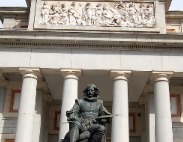
Museo del Prado
Spain is hands down home to some of the world’s best painters, sculptors, architects and writers. This is because many cultures – such as the Romans, French, Portuguese and Moors – plus many events like the Reconquista, Renaissance and the Spanish Civil War greatly influenced the minds and works of Spain’s best artists. Art flourished throughout Spain during the 18th, 19th and 20th centuries and some of the famous styles and world-renowned artists that emerged were: Mannerism by El Greco, the Baroque style by artists such as Francisco Zurbaran and Diego Valezquez, Romanticism by Francisco Goya, Impressionism and Post-Impressionism by Sorolla and the Modernist art by Picasso and Salvador Dali.
Unfortunately, there’s not enough space in this article to explore the beautiful art by the aforementioned artists. But luckily for art enthusiasts the Museo del Prado, located in Madrid, houses nearly 7,600 paintings, 4,800 prints, 8,200 drawings and 1,000 sculptures from Europe’s best artists.
Museo del Prado
Every year nearly 3 million people flock to the impressive museum located in Paseo del Prado, Madrid, Spain. El Prado is one of the finest places in the world to view the most important European collections of art from the 12th to 19th centuries. What’s more, it’s ranked 11th in the world because it displays a wide variety of art from a host European nations like Spain, Italy, France, Germany, Britain and Greece. Most of the works on display were taken from the huge Spanish Royal Collection.
For fanatics of Spanish art, El Prado displays the largest collection of Spanish art in the world with more than 4,800 paintings from Spain’s preeminent artists. Enthusiasts marvel at the fact that the Goya collection contains his finest masterpieces (La maja desnuda and The Family of Charles IV) and showcases more than 140 paintings while the Velazquez collection displays more than 50 of his top-paintings. In fact, El Prado’s most famous painting Las Meninas is by Velazquez.
But don’t just marvel at the breathtaking beauty located inside El Prado, check out the building itself. The building boasts an extravagant architectural design that was intended to give Madrid a monumental urban space. Construction began in 1785 during the rule of Charles III and during the reign of Ferdinand VII it became the Royal Museum of Painting and Sculpture on November 19, 1819.
One fun fact about El Prado was that it housed Napoleon’s cavalry and gunpowder during the War of Independence. It was a challenge to preserve the art collection during this war, so it was transferred to Geneva, Switzerland. During the Second World War, the entire collection returned home unscathed to Madrid from Geneva. Thankfully, it’s all on display to this very day for millions of art enthusiasts to enjoy its rich history and beauty.
 Follow
Follow


